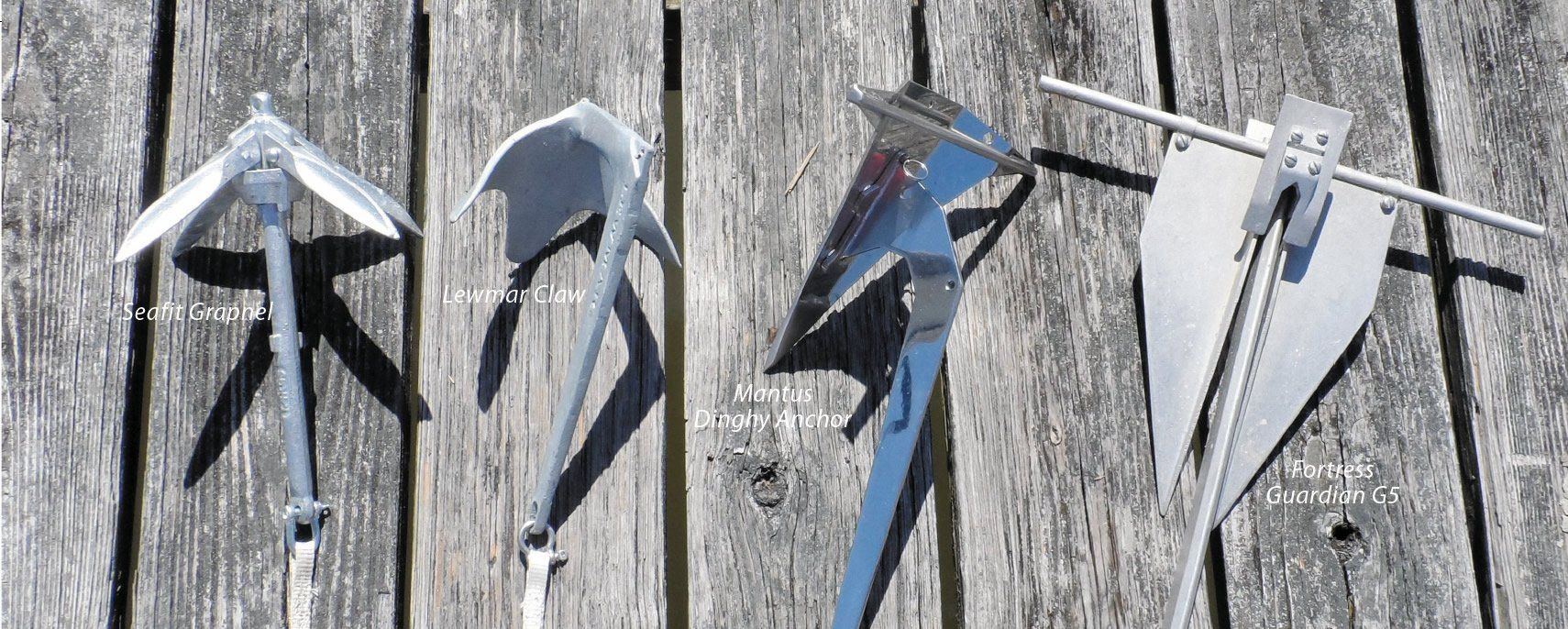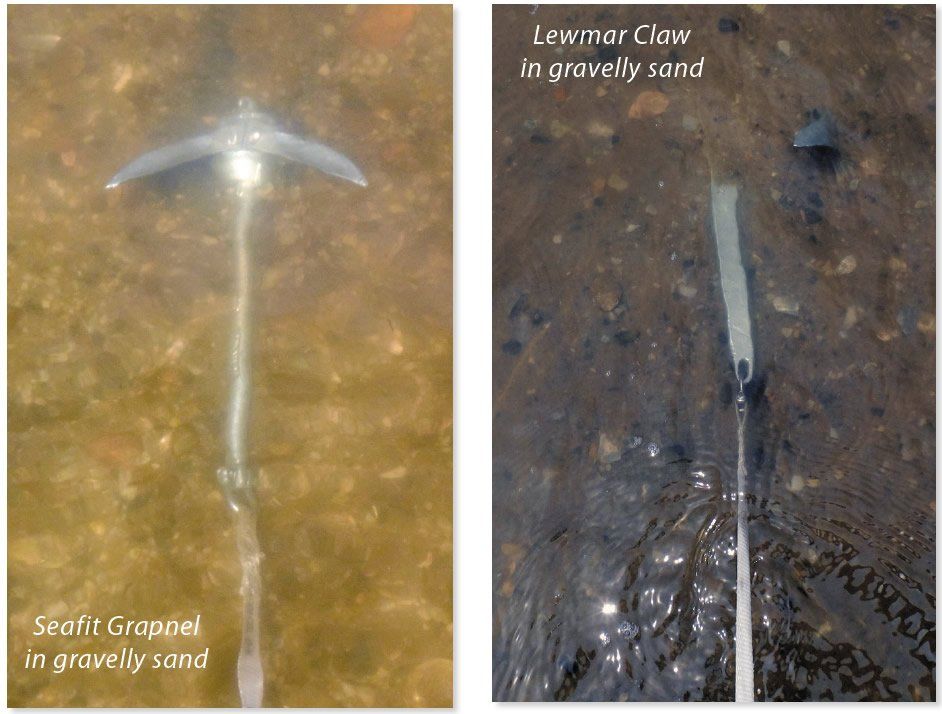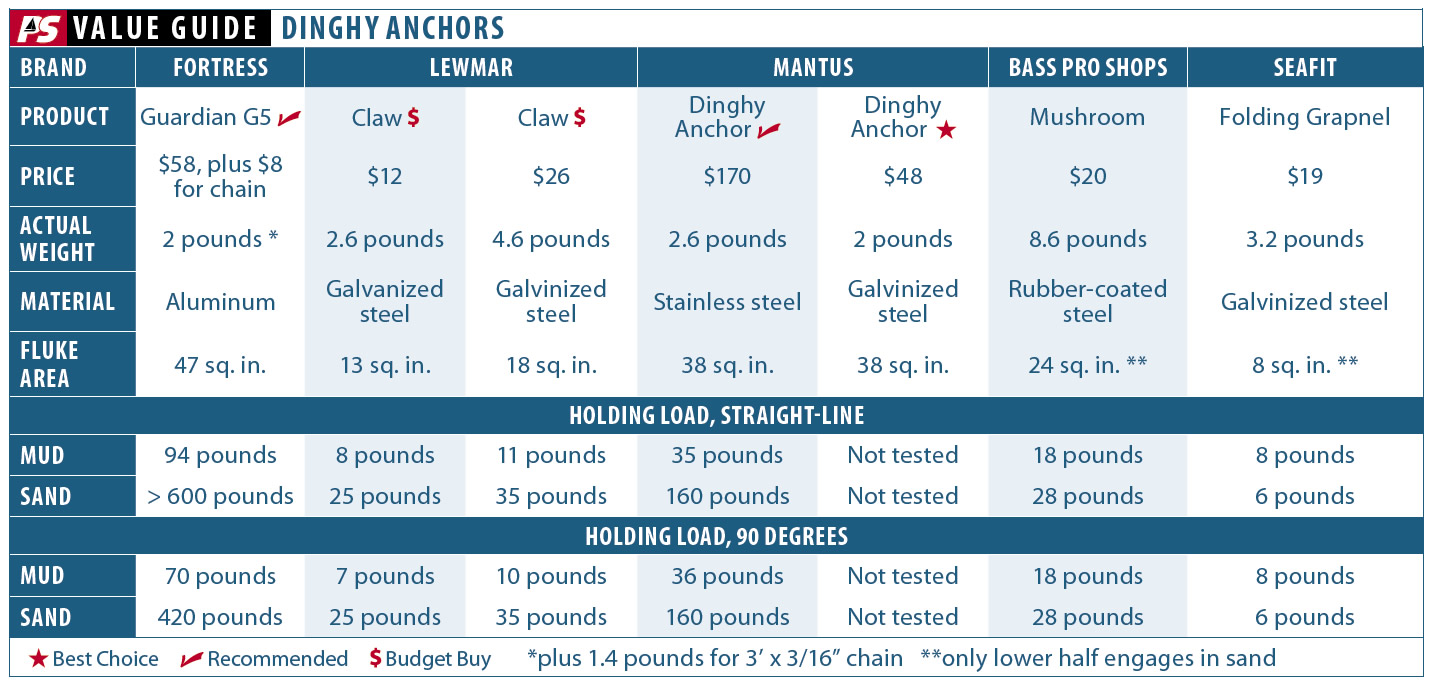Sailors spend considerable time pondering their anchoring arsenal for the mothership, but what about the dinghy? With the new Mantus Dinghy Anchor, it seems that all of the design schools are now represented in small sizes. We were interested to determine which of these might offer the best performance.
What We Tested
We focused on easy-to-manage anchors weighing 2 to 3 pounds. Five piqued our interest. The Guardian G5 is a scaled-down version of the respected Fortress anchor. The Lewmar Claw is a descendant of the familiar Bruce anchor. The Mantus Dinghy Anchor, a scoop-type anchor, is the new kid on the block. Finally, we included a 1.5-pound Seafit Folding Grapnel and a typical, 8-pound mushroom anchor to round out the field. Our test protocol, similar to tests we have done on larger anchors (see PS February 2015 online), was carried out using multiple boats, including a 34-foot catamaran. See the accompanying How We Tested on right for test details.
Photos by Drew Frye

Observations
Each anchor behaved similar to its big brother wed recently tested (PS February 2015), with the caveat that the smaller anchors have difficulty with hard bottoms and clog more easily with weeds and debris.
In the dinghy anchor test, all except the mushroom and grapnel buried well in soft mud. In firm sand, the Guardian G5 dug as deep as 15 inches; the Mantus Dinghy Anchor dug about 6 to 8 inches deep; the Claw dug very little or buried on one side; and the mushroom and grapnel stayed on top with only one side engaged.
Advertised anchor weights are not exact. We weighed the test anchors, which all varied some from advertised weights. The actual weights are listed in the accompanying Value Guide.
Check any anchor for sharp corners before taking it onboard an inflatable dinghy. Several test anchors had rough spots that could easily pop a tube. Simply file down the offending spot.
Photos by Drew Frye

Fortress Guardian G5
With the greatest fluke area, Fortress Anchors Guardian G5 put up the biggest holding numbers with the least weight. Its ability to track though the 90-degree shift without resetting was surprising. It managed to reset fine, as long as the rode had significant tension. However, during a sudden 90-degree or 180-degree shift, it was likely to pop out and had trouble resetting.
The best policy with pivoting fluke anchors is to set them very hard. If the dinghy has a good engine, backing down should be enough. However, if the dinghy is human-powered, setting force is low, and it might not hold well.
Testers never had trouble retrieving the Guardian G5 when it was set from the dinghy during tests, but when it was set from the catamaran, it took substantial upward pressure to retrieve it-requiring snubbing to a cleat and letting the waves work on it.
The 2-pound Guardian was occasionally fussy in soft mud, trashy mud (tended to clog with debris), and hard bottoms (not enough mass to bite); the cure was a short length of chain (4 to 6 feet of quarter-inch chain), which increases the total weight to 4 pounds.
Its large size makes storage awkward, but it is flat, and we were always able to find a place for it. Our test anchor has proved its durability over almost 20 years of service.
Bottom line: There are easier-to-manage options for dinghies, but the Guardian did well in mud and would be a good choice for stern-to-shore mooring. It is Recommended.
Lewmar Claw
With the smallest fluke area, the 2.2-pound Lewmar Claw didnt put up big numbers. However, it set no matter how casually we tossed it, offered some resistance even on short scope, and was the easiest to store, with an odd shape but no sharp corners. We preferred it as a kayak anchor, where simplicity, small size, and ease of use matter most; just pitch it, and it will catch every time.
However, its holding power, particularly in mud, is limited. We often anchor our dinghy just off the beach in wading depth, vulnerable to chop and the occasional wake; the small Claw would sometimes slowly drag through the gravelly sand that is common in the impact zone. Thus, for a tender, we think the 4.4-pound model is a better choice.
Bottom line: Lewmars prices are hard to beat. The smaller size is the Budget Buy for kayaks, and the 4.4-pound version is the Budget Buy for dinghies.

Mantus Dinghy Anchor
The Mantus is the only 2-pound anchor weve ever felt safe leaving the dinghy attached to. During testing, the dinghy felt as though it were nailed to the bottom. We even used it as a lunch hook for an 8,000-pound catamaran on good sand, to see how it would hold when really challenged. Though it would start to drag when white caps came up, the holding remained steady and the force required was substantial.
We tested the stainless version, which features a clever and simple mechanism for disassembly and flat storage. Although the two-piece design is popular with the jetski crowd, we seldom disassembled ours. It also would be awfully tempting to thieves if left in the dinghy. The welded, one-piece galvanized version strikes us as more practical for the sailor looking for a dinghy anchor.
One concern testers had was that the Mantus would not right itself if it flipped over (the larger version features a roll bar to aid in self-righting), but this was never an issue during a season of testing.
Price is the biggest drawback. Investing $170 in a stainless dinghy anchor would invite theft in many places. The $48 galvanized anchor makes more sense to us.
Bottom line: Your dinghy is safe with the Mantus, our Best Choice. We preferred the welded, galvanized version.
Mushroom anchor
The mushroom anchor we tested is a common style found in most marine stores. We had low expectations, but there was a lot to like about it.
Made of rubber-coated steel, it has no sharp corners to endanger inflatable tubes. You simply dump it over the side, and it holds well enough in moderate conditions. We couldnt give it a high rating because it was above our weight criteria, but mushroom anchors are cheap, easy, and will certainly serve as the dinghy equivalent of a lunch hook.
Bottom line: Unrated. A handy-if not hefty-choice for easy setting and retrieval when you don’t care if you drag a bit.
Seafit Folding Grapnel
With minimal fluke area, the 3-pound Seafit Folding Grapnel anchor performed poorly in mud as expected, but we were shocked how inefficient it also was in sand. Even the kayak managed to drag the 1.5-pound version in a breeze. In wavy conditions, the dinghy dragged with the 3.2-pound version.
Bottom line: The compact storage isn’t worth the hassle and poor holding.
Conclusions
The Mantus Dinghy Anchor, though not cheap, clearly stood out in tests. It brings modern anchor performance to the very-small boat category; strong holding and perfect veer behavior make it a good choice for anchoring out. The Guardian G5 was impressive in mud and will serve well for stern-to-shore mooring, but is bulkier than the Mantus. Testers also liked the bigger Lewmar Claw for its economy and simplicity. As for the mushroom and the folding grapnel, they no longer make sense to us. The Claw earned a long-term home in our kayak, and the Mantus a place in the inflatable.









































While I prefer grapnels, I consider claw anchors the most versatile of the three. As long as their size can accommodate my boat, I tend to bring them along. They’re not hard to set because they hold well on most types of bottoms. Another perk is that they automatically align with the wind and tide.